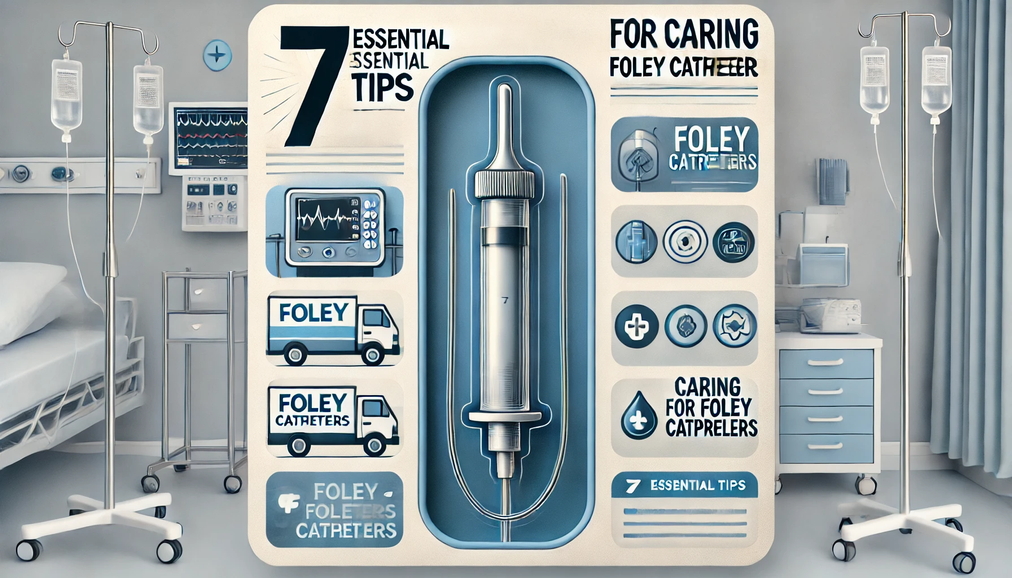
7 Essential Tips for Caring for Foley Catheters
Posted by Pankaj Dhiman on Jan 3rd 2025
Caring for a Foley catheter can be daunting, especially if you or a loved one is using one for the first time. However, with proper knowledge and guidance, you can manage it effectively and ensure both comfort and safety. This blog will cover seven essential tips to help you care for a Foley catheter properly.
1. Understand the Basics of Foley Catheters
A Foley catheter is a flexible tube inserted into the bladder to drain urine. It’s often used for patients who have difficulty urinating naturally due to surgery, injury, or medical conditions. Foley catheters come in various sizes and materials, such as silicone or latex, and may stay in place for days or weeks.
Why it’s important: Knowing how the catheter works helps you take proactive measures to avoid complications, such as infections or blockages.
Must Read: A Guide to Choosing the Right Urinary Catheter
2. Maintain Proper Hygiene
Cleanliness is critical to preventing infections. Always wash your hands thoroughly with soap and water before and after handling the catheter or drainage bag.
Tips for cleaning the catheter:
- Use mild soap and warm water to clean the area around the insertion site daily.
- Avoid using alcohol-based products or harsh cleansers that could irritate the skin.
- Pat the area dry gently with a clean towel.
Why it’s important: Poor hygiene can lead to urinary tract infections (UTIs), which can cause severe discomfort and complications.
3. Position the Drainage Bag Correctly
The placement of the drainage bag is crucial for proper urine flow and to avoid backflow, which can cause infections.
Key points:
- Always keep the drainage bag below the level of the bladder to ensure gravity aids urine flow.
- Avoid placing the bag on the floor to reduce the risk of contamination.
- Ensure the tubing is free of kinks or loops to prevent blockages.
Why it’s important: Incorrect bag placement can lead to urine retention, discomfort, and increased infection risk.
Must Read: Urinary Catheters: Types, Uses, Care, and Risks
4. Empty the Drainage Bag Regularly
Empty the drainage bag when it is about two-thirds full or every 6-8 hours, whichever comes first. If your healthcare provider requires it, use a clean container to measure the urine output.
Steps to empty the bag:
- Wash your hands thoroughly.
- Open the drainage spout at the bottom of the bag.
- Let the urine flow into a clean receptacle.
- Close the spout securely and wipe it clean.
- Wash your hands again.
Why it’s important: Regular emptying prevents overfilling, which can cause leaks and increase the risk of infections.
Must Read: What are Urinal Drain Bags? Benefits, How to Use, and Applications
5. Check for Signs of Infection
Stay vigilant for any signs of infection, which can include:
- Cloudy or foul-smelling urine.
- Blood in the urine.
- Fever, chills, or back pain.
- Redness, swelling, or discharge around the insertion site.
If you notice any of these symptoms, contact your healthcare provider immediately.
Why it’s important: Early detection and treatment of infections can prevent severe health complications.
6. Prevent Tugging and Pulling
Accidental tugging or pulling on the catheter can cause pain, irritation, or even dislodgement.
Tips to avoid tugging:
- Secure the catheter tubing to your leg using medical-grade adhesive or a catheter strap.
- Wear loose-fitting clothing to minimize pressure on the catheter.
- Be mindful of the tubing during activities such as sleeping or walking.
Why it’s important: Proper catheter securing prevents discomfort and reduces the risk of injury to the urethra.
7. Follow Your Healthcare Provider’s Instructions
Your healthcare provider will give you specific guidelines based on your condition and the type of catheter you’re using. Follow these instructions carefully, and don’t hesitate to ask questions if you’re unsure about anything.
Common instructions include:
- How often to replace the catheter.
- Proper cleaning techniques.
- Dietary recommendations to promote bladder health.
Why it’s important: Adhering to professional advice ensures optimal care and minimizes potential risks.
Explore:Best-Selling Powder-Free Exam Gloves in 2025
FAQs
1. How often should the catheter be replaced?
The frequency of replacement depends on your healthcare provider’s recommendations, but generally, Foley catheters are replaced every 2-4 weeks.
2. Can I shower with a Foley catheter?
Yes, you can shower with a Foley catheter. Ensure the catheter and tubing are securely attached, and avoid soaking in baths unless advised by your healthcare provider.
3. What should I do if the catheter becomes blocked?
If you notice reduced urine flow or no output, check for kinks in the tubing. If the issue persists, contact your healthcare provider immediately.
4. Are there any dietary restrictions while using a Foley catheter?
Drinking plenty of fluids, especially water, can help maintain proper urine flow and reduce the risk of infections. Avoid excessive caffeine and alcohol as they may irritate the bladder.
5. How can I reduce discomfort while using a Foley catheter?
Ensure the catheter is secured properly to prevent tugging, wear loose clothing, and follow hygiene practices to avoid irritation.
Conclusion
Caring for a Foley catheter may seem challenging at first, but by following these seven essential tips, you can ensure comfort and reduce the risk of complications. Remember, maintaining proper hygiene, positioning the drainage bag correctly, and adhering to your healthcare provider’s instructions are key to successful catheter management. If you experience any issues or have concerns, always consult your healthcare provider promptly.
With the right approach, Foley catheter care can become a manageable part of your daily routine.
